人教版九年级英语全一册教案-Unit6Whenwasitinvented精品教案
- 格式:pdf
- 大小:53.01 KB
- 文档页数:24
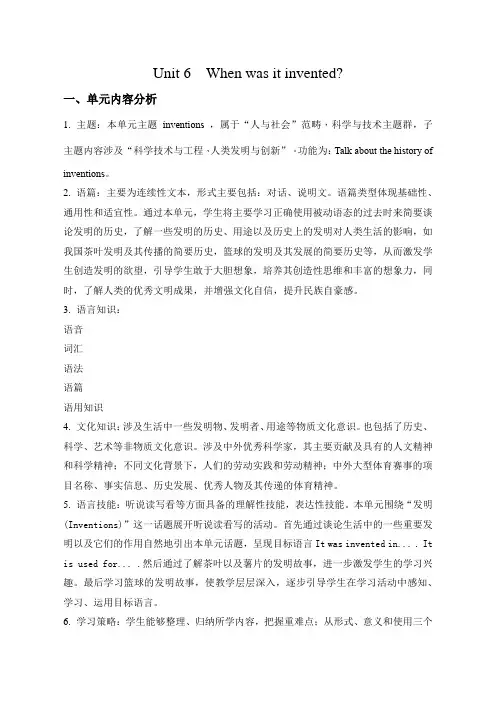
Unit 6 When was it invented?一、单元内容分析1.主题:本单元主题inventions ,属于“人与社会”范畴,科学与技术主题群,子主题内容涉及“科学技术与工程、人类发明与创新”。
功能为:Talk about the history of inventions。
2.语篇:主要为连续性文本,形式主要包括:对话、说明文。
语篇类型体现基础性、通用性和适宜性。
通过本单元,学生将主要学习正确使用被动语态的过去时来简要谈论发明的历史,了解一些发明的历史、用途以及历史上的发明对人类生活的影响,如我国茶叶发明及其传播的简要历史,篮球的发明及其发展的简要历史等,从而激发学生创造发明的欲望,引导学生敢于大胆想象,培养其创造性思维和丰富的想象力,同时,了解人类的优秀文明成果,并增强文化自信,提升民族自豪感。
3.语言知识:语音词汇语法语篇语用知识4.文化知识:涉及生活中一些发明物、发明者、用途等物质文化意识。
也包括了历史、科学、艺术等非物质文化意识。
涉及中外优秀科学家,其主要贡献及具有的人文精神和科学精神;不同文化背景下,人们的劳动实践和劳动精神;中外大型体育赛事的项目名称、事实信息、历史发展、优秀人物及其传递的体育精神。
5.语言技能:听说读写看等方面具备的理解性技能,表达性技能。
本单元围绕“发明(Inventions)”这一话题展开听说读看写的活动。
首先通过谈论生活中的一些重要发明以及它们的作用自然地引出本单元话题,呈现目标语言It was invented in... . It is used for... .然后通过了解茶叶以及薯片的发明故事,进一步激发学生的学习兴趣。
最后学习篮球的发明故事,使教学层层深入,逐步引导学生在学习活动中感知、学习、运用目标语言。
6.学习策略:学生能够整理、归纳所学内容,把握重难点;从形式、意义和使用三个角度关注和使用语法;了解和运用各种阅读阅读技巧和策略,如mind mapping;了解和运用基本的写作技巧和策略。
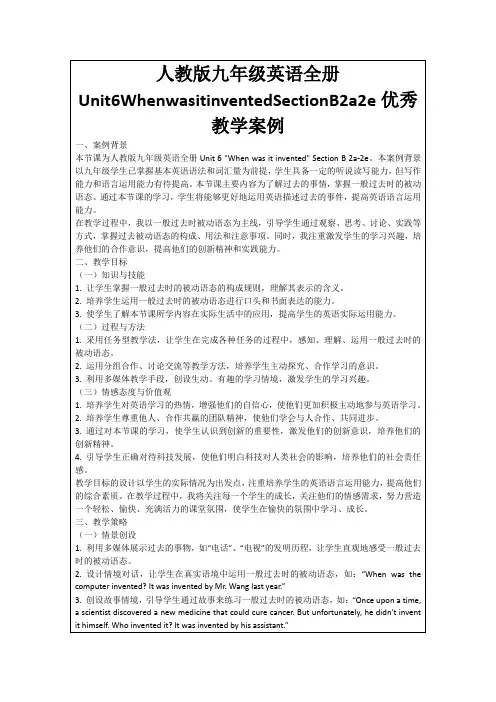
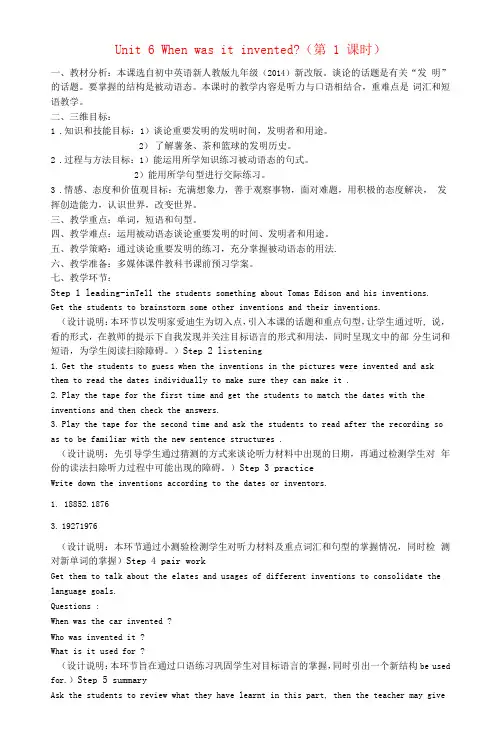
Unit 6 When was it invented?(第 1 课时)一、教材分析:本课选自初中英语新人教版九年级(2014)新改版。
谈论的话题是有关“发明”的话题。
要掌握的结构是被动语态。
本课时的教学内容是听力与口语相结合,重难点是词汇和短语教学。
二、三维目标:1 .知识和技能目标:1)谈论重要发明的发明时间,发明者和用途。
2)了解薯条、茶和篮球的发明历史。
2.过程与方法目标:1)能运用所学知识练习被动语态的句式。
2)能用所学句型进行交际练习。
3.情感、态度和价值观目标:充满想象力,善于观察事物,面对难题,用积极的态度解决,发挥创造能力,认识世界,改变世界。
三、教学重点:单词,短语和句型。
四、教学难点:运用被动语态谈论重要发明的时间、发明者和用途。
五、教学策略:通过谈论重要发明的练习,充分掌握被动语态的用法.六、教学准备:多媒体课件教科书课前预习学案。
七、教学环节:Step 1 leading-in Tell the students something about Tomas Edison and his inventions.Get the students to brainstorm some other inventions and their inventions.(设计说明:本环节以发明家爱迪生为切入点,引入本课的话题和重点句型,让学生通过听, 说,看的形式,在教师的提示下自我发现并关注目标语言的形式和用法,同时呈现文中的部分生词和短语,为学生阅读扫除障碍。
)Step 2 listening1.Get the students to guess when the inventions in the pictures were invented and ask them to read the dates individually to make sure they can make it .2.Play the tape for the first time and get the students to match the dates with the inventions and then check the answers.3.Play the tape for the second time and ask the students to read after the recording so as to be familiar with the new sentence structures .(设计说明:先引导学生通过猜测的方式来谈论听力材料中出现的日期,再通过检测学生对年份的读法扫除听力过程中可能出现的障碍。
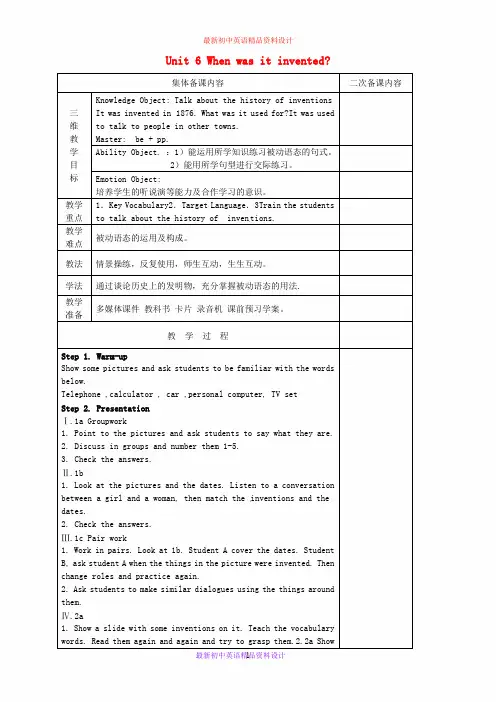
Unit 6 When was it invented?集体备课内容二次备课内容三维教学目标Knowledge Object: Talk about the history of inventions It was invented in 1876. What was it used for?It was used to talk to people in other towns.Master: be + pp.Ability Object. :1)能运用所学知识练习被动语态的句式。
2)能用所学句型进行交际练习。
Emotion Object:培养学生的听说演等能力及合作学习的意识。
教学重点1.Key Vocabulary2.Target Language.3Train the students to talk about the history of inven tions.教学难点被动语态的运用及构成。
教法情景操练,反复使用,师生互动,生生互动。
学法通过谈论历史上的发明物,充分掌握被动语态的用法.教学准备多媒体课件教科书卡片录音机课前预习学案。
教学过程Step 1. Warm-upShow some pictures and ask students to be familiar with the words below.Telephone ,calculator , car ,personal computer, TV setStep 2. PresentationⅠ.1a Groupwork1. Point to the pictures and ask students to say what they are.2. Discuss in groups and number them 1-5.3. Check the answers.Ⅱ.1b1. Look at the pictures and the dates. Listen to a conversation between a girl and a woman, then match the inventions and the dates.2. Check the answers.Ⅲ.1c Pair work1. Work in pairs. Look at 1b. Student A cover the dates. Student B, ask student A when the things in the picture were invented. Then change roles and practice again.2. Ask students to make similar dialogues using the things around them.Ⅳ.2a1. Show a slide with some inventions on it. Teach the vocabulary words. Read them again and again and try to grasp them.2.2a Showanother slide. Look at the picture. Here are the three inventions. You will hear a conversation between a girl and a boy. Listen and number the inventions in the order that you hear them.3. Listen carefully again and check up their answers.4. Ask a student to say out his / her answer.5. The teacher shows the correct answers.Ⅴ. 2b1. Show another slide. Look at the chart. It shows the people who invented these things and what they are used for. Listen to the recording again and match the items in column A, B and C.2.. Play the tape again, then check the answers.Ⅵ.2c Pair work1. Ask the students to pay attention to the sample conversation and ask two students to read it aloud.2. Role play the conversations using the information in the chart in 2b.Homework:1. Copy grammar twice.2.Ask the students to do the workbook and Recite words.课后反思本节课成功之处:本节课需改进的地方:九年级英语学科全册第 6单元(章)单元(章)名称、课题Unit 6 When was it invented?课时划分4课时教学课时第 2课时总备课数第课时主备人备课组其他成员集体备课内容二次备课内容三维教学目标Knowledge Object:hat are they used for? When was it invented? Who was it invented by?Master: be + pp.Ability Object. :1)能运用所学知识练习被动语态的句式。
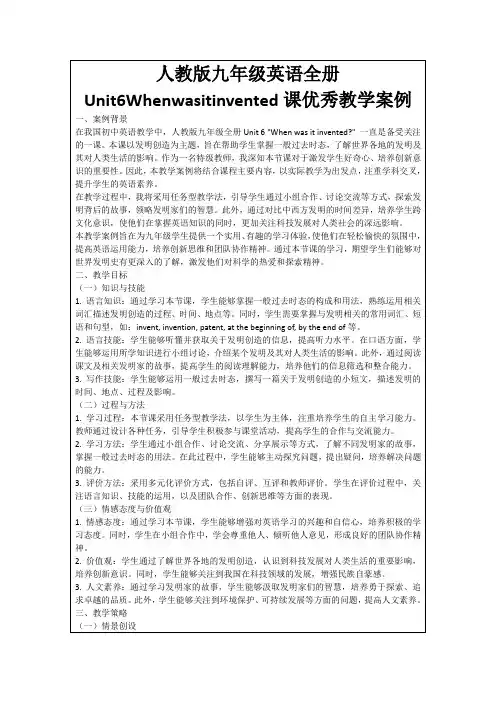
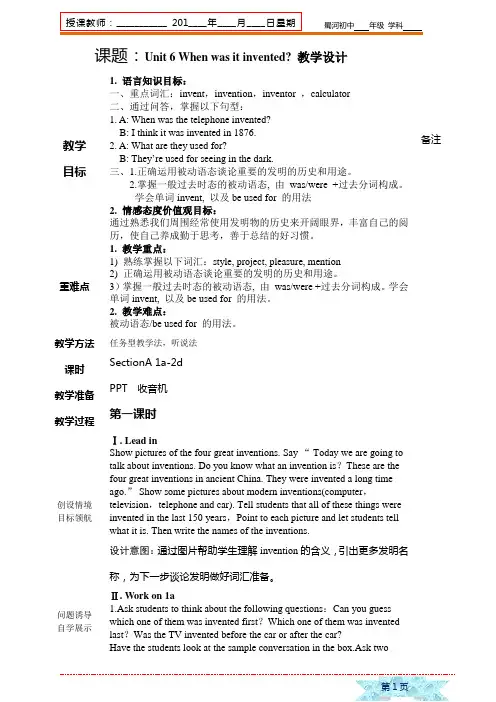
课题:Unit 6 When was it invented? 教学设计教学目标1. 语言知识目标:一、重点词汇:invent,invention,inventor ,calculator二、通过问答,掌握以下句型:1. A: When was the telephone invented?B: I think it was invented in 1876.2. A: What are they used for?B: They’re used for seeing in the dark.三、1.正确运用被动语态谈论重要的发明的历史和用途。
2.掌握一般过去时态的被动语态, 由was/were +过去分词构成。
学会单词invent, 以及be used for 的用法备注2. 情感态度价值观目标:通过熟悉我们周围经常使用发明物的历史来开阔眼界,丰富自己的阅历,使自己养成勤于思考,善于总结的好习惯。
重难点1. 教学重点:1) 熟练掌握以下词汇:style, project, pleasure, mention2) 正确运用被动语态谈论重要的发明的历史和用途。
3)掌握一般过去时态的被动语态, 由was/were +过去分词构成。
学会单词invent, 以及be used for 的用法。
2. 教学难点:被动语态/be used for 的用法。
教学方法任务型教学法,听说法课时SectionA 1a-2d 教学准备PPT 收音机教学过程第一课时创设情境目标领航Ⅰ. Lead inShow pictures of the four great inventions. Say “ Today we are going to talk about inventions. Do you know what an invention is?These are the four great inventions in ancient China. They were invented a long time ago.” Show some pictures about modern inventions(computer,television,telephone and car). Tell students that all of these things were invented in the last 150 years,Point to each picture and let students tell what it is. Then write the names of the inventions.设计意图:通过图片帮助学生理解invention的含义,引出更多发明名称,为下一步谈论发明做好词汇准备。
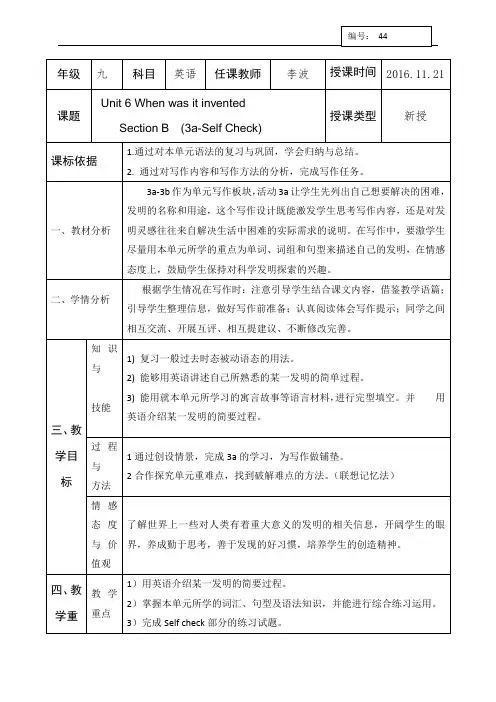
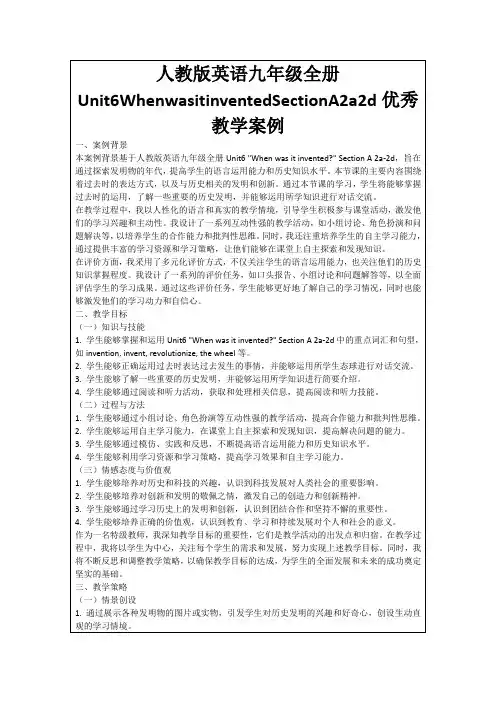
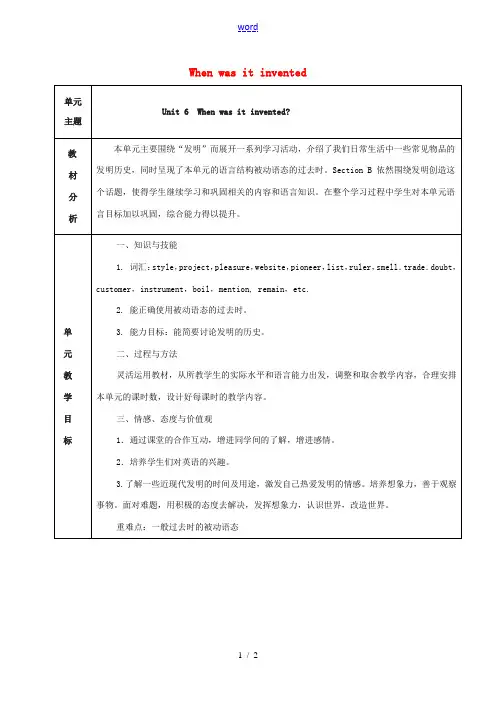
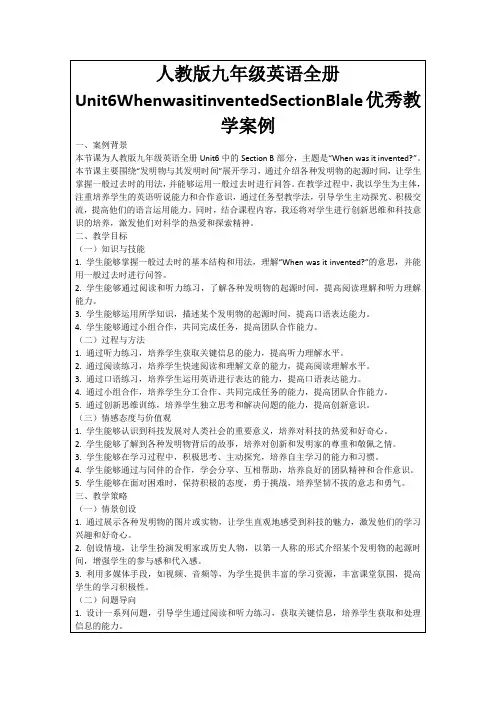
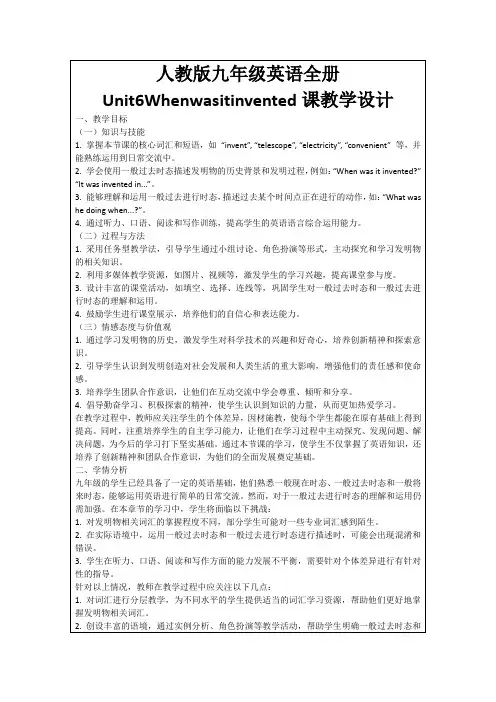
新目标九年级英语Unit 6 When was it invented?第一课时教学设计驻操营学区初级中学邵艳翠一、教学内容分析:《When was it invented》为人教版英语新目标九年级第六单元教学内容,重在谈论重要发明的历史及用途,开阔学生的思路,培养学生的创造精神,同时进一步学习被动语态的用法。
被动语态在前几单元已经涉及,本节主要加深对被动语态的理解及句式的运用。
二、学情分析:九年级学生具备了一定的自学能力,并渴望在集体或小组中展示自己的才能,对电脑的兴趣较浓,也具备一些计算机的操作技能。
所以本节课主要采用学生自主学习与小组合作学习相结合的方式,教师适时布置任务型活动并加以点拨。
整堂课在生生、师生、生机互动中完成教学任务。
三、教学目标1)知识目标:学习一般过去时的被动语态和特殊疑问句。
2)技能目标:能谈论重要发明的历史及用途,能针对各项发明的用处及特点,发表自己的看法,并说明理由。
3)情感目标: 使学生懂得人类的科学发明创造了丰富的物质文明,培养学生的创造发明的能力和愿望。
四、教学重点、难点教学重点:掌握一般过去时的被动语态教学难点:弄清主动语态与被动语态的差异,通过练习和运用加以巩固。
五、教学设计思路与教材处理:《新目标英语》中的具体语言目标是通过各种各样的Tasks来实现的;学生需要运用具体而特定的行动来完成一定的交际任务。
整个教学过程中,各种语言结构与语言功能与不同的学习任务有机的结合。
任务活动所谋求的效果不是一种机械的语言训练,而是侧重在执行任务中学生自我完成任务的能力和策略的培养;重视形式在完成任务过程中的参与和在交流活动中所获得的经验。
因此本节课我将始终引导学生通过完成具体的任务活动来学习语言,让学生为了特定的学习目的去实施特定的语言行动,通过完成特定的交际任务来获得和积累相应的学习经验,让学生在用中学,学中用。
六、教学方法:本单元主要采用任务型教学法和情境教学法。
教学反思:本节课充分利用现代信息技术和信息资源,改革教学方式和学生学的方法,培养学生探索、实践、思考和综合运用能力,最终达到利用信息技术改善学习的目的,让学生主动参与,增强自主探究的能力,让信息技术在英语教学中发挥最大优势,提高英语的教学效率和教学质量。
人教版九年级英语《Unit 6 When was it invented?》教学设计一. 教材分析人教版九年级英语《Unit 6 When was it invented?》主要介绍了与日常生活相关的科学技术发明的历史。
本单元包括一般过去时的被动语态,以及表示过去某段时间经常发生的动作或存在的状态的用法。
本节课旨在让学生掌握一般过去时的被动语态,能够运用本课所学内容进行交流。
二. 学情分析九年级的学生已经具备了一定的英语基础,能够听、说、读、写简单的英语句子。
但部分学生在语言表达方面仍有困难,需要教师的耐心引导和鼓励。
此外,学生对于科技发明的历史知识了解有限,需要在教学过程中进行补充。
三. 教学目标1.知识目标:–掌握一般过去时的被动语态。
–了解与日常生活相关的科学技术发明的历史。
2.能力目标:–能够运用一般过去时的被动语态进行交流。
–提高学生的听说读写能力。
3.情感目标:–激发学生对科学技术发展的兴趣。
–培养学生的创新意识。
四. 教学重难点•一般过去时的被动语态。
•与日常生活相关的科学技术发明的历史。
•一般过去时的被动语态的运用。
•对科学技术发明历史的理解。
五. 教学方法1.情境教学法:通过设定情境,让学生在实际语境中学习、运用英语。
2.交际法:引导学生进行互动交流,提高口语表达能力。
3.任务型教学法:通过完成任务,培养学生综合运用英语的能力。
4.启发式教学法:引导学生主动思考,激发学习兴趣。
六. 教学准备1.教材:人教版九年级英语《Unit 6 When was it invented?》。
2.辅助材料:科技发明历史的相关图片、视频等。
3.多媒体设备:投影仪、电脑等。
4.教学卡片:一般过去时的被动语态的句子。
七. 教学过程1.导入(5分钟)利用图片或视频介绍科学技术发明的历史,激发学生的兴趣。
引导学生谈论自己了解的科技发明,复习一般过去时。
2.呈现(10分钟)展示本节课的主要内容,引导学生关注一般过去时的被动语态。
Unit 6 When was it inventedSection A 3 (3a-3c)一、Teaching aims:1. Knowledge Objects:1) Key words2)Improve students' reading ability by reading.3) To understand the history of tea production and the process of production.2. Moral Objects::In the face of difficult problems, with a positive attitude to solve.二、Teaching Key Points and Difficulties1. Key Points:1) Master the new words and phrases in this part of the new words and phrases.2) Read and get the main ideas. Improve the reading ability by reading practice.2. Difficulties:1) Read an d get the main ideas. Improve the reading ability by reading practice.三、Teaching Procedures:Ⅰ. Revision1. Check the homework.2. Role-play the conversation in 2d.Ⅱ. Lead-in一、Playing video of "the origin of tea", let students understand the culture of Chinese tea, and tea was invented, and to understand the development process.1. What is the video about?2. Who is the writer of Cha Jing?Ⅲ. ReadingWork on 3a:1. Tell Ss to read the article quickly and match each paragraph with its main idea. Para. 1Para. 2Para. 3Ss read the article quickly and match each paragraph with its main idea.Para. 1 How tea was invented by accidentPara. 2 Lu Yu and his book Cha JingPara. 3 How tea spread to other countriesWork on 3b:1. Tell the students to read the passage again and answer all the questions in 3b.2. The students read the questions first, understand what they mean, and then take the questions to read the passage carefully and underline the relevant information.3. Ask Ss to answer the questions and check the answers.4. Read the answers and then correct them.Ⅳ. Post readingRead and fill the blanks.Fill the blanks according to the first paragraph.Tea (after water), the most popular drink in the world _______ (invent) by accident. It is believed that tea _______ (drink) 5,000 years ago. It ______ (say) that a Chinese ruler ______ (call) Shen Nong was the first ______ (discover) tea as a drink. One day Shen Nong _______ (boil) drinking water over an open fire. Some leaves from a tea plant ____ (fall) into the water and remained there for some time. It ________ (produce) a nice smell so he ______ (taste) the brown water. It was quite delicious, and so, one of the world’s favorit e drinks _________ (invent).2. Fill the blanks according to the second paragraph.Lu Yu, “the saint of tea”, ___ (mention) Shen Nong in his book Cha Jing a few thousand years later. The book describes how tea plants __ and used to make tea. It also discusses where the finest tea leaves ___ (produce) and what kinds of water ___ (use).3. Fill in the blanks with the proper forms .People believed that tea _______ (bring) to Korea and Japan during the 6th and 7th centuries. In England, tea ________ (not appear) until around 1660, but in less than 100 years, it had become the national drink. The tea trade from China to Western countries ______ (take) place in the 19th century.Work on 3c. Complete the sentences with the correct forms of the verbs in the box. VI. Exercises一、选词填空 smell, remain, ruler, boil, national1. October 1st is __________ Day in China.2. Humans are the _____ of the earth.3. When fish goes bad, it _______ terrible.4. They _________ in that forest for a year.5. Water ______ at 100℃.二、1. I found the key __________ (偶然) when I was cleaning the house.2. The May 4 Movement ___________(发生)in Beijing in 1919.3. He’ll succeed ____________ (毫无疑问) this time.4. ________ (据说) Shen Nong was the first to discover tea as a drink.5. Tea _________________(被带到) Korea and Japan during 6th and 7th centuries. Homework1. Read the passage several times after school.2. Make sentences with these words:by accident, it is believed that, take place, no doubt, be used for, fall into Teaching notes:。
Unit 6 When was it invented?Section A 1 (1a-1c)一、教学目标:1. 知识与技能:1) Master the sentences:—When was the telephone invented?—I think it was invented in 1876.2)Be able to talk about the history of inventions using the passive voice of past tense.3)Train students’ listening and communicative skills.2. 过程与方法:1. Lead in the target language through listening and speaking practice.2. Autonomous and cooperative approach.3. 情感态度与价值观:Learn about the history of some great inventions. Lead students to know theimportance of inventions in our daily life.二、教学重难点1. 教学重点:1) Master the key sentences.2)Learn to talk about the history of inventions using the passive voice of past tense.3)Improve students’ listening and speaking skills.2. 教学难点:How to talk about the history of inventions using the passive voice of past tense. 三、教具ppt, some handouts四、教学过程Step 1 情景导入Step 2 自主学习1.Show the pictures of three inventions and inventors on the screen: a car,a TV and a telephone. Give students an example: “Benz invented the first car. →The first car was invented by Benz.”2.Ask students to change the other two sentences into passive voice.3.Give students an example: “I think the TV was invented before the car.”4.Finish 1a. Ask students to guess in groups and make up conversations according to 1a.5.Check students’ conversations.6.Finish 1b. Listen and match the inventions with the years.7.Read the conversation in 1c in groups.8.Choose an invention to talk about, like the conversation in 1c.Step 3 我的疑问学生质疑Step 4 合作探究1.观察下面的句子,完成下面的空格。
Unit 6 When was it invented?Section A 1 (1a-2d)一、教学目标:1. 语言知识目标:1) 能掌握以下单词:heel, scoop, electricity, style, project, pleasure, zipper, daily,website, pioneer, list, mention能掌握以下句型:①—When was the telephone invented?—I think it was invented in 1876.②—What are they used for?—They are used for seeing at night.2) 能谈论物品被发明的时间、发明者,表达某发明的用途。
2. 情感态度价值观目标:了解一些近现代发明的时间及用途,激发自己热爱发明的情感。
培养想象力,善于观察事物。
面对难题,用积极的态度去解决,发挥想象力,认识世界,改造世界。
二、教学重难点1. 教学重点:1) 本课时的单词、词组和句型,学习运用一般过去时态的被动语态。
2) 学会询问发明时间及用途的基本句型:—When was the telephone invented?—I think it was invented in 1876.—What are they used for?—They are used for seeing at night.2. 教学难点:运用一般过去时态的被动语态来讨论发明的发明时间及用途。
三、教学过程I. Warming up1. 展示一些近代发明的图片与近代发明的发明者,让学生们将图片与发明者相连。
T: Do you know what these inventions are?S1: It’s a car.S2: It’s a telephone.S3: It’s a television.T: Do you know who these inventors are?S1: Karl BenzS2: Alexander BellS3: J. L. BairdLet Ss match the inventions and the inventors.Ⅱ. Presentation引导学生们学习一般过去时态的被动语态结构。
让学生们看大屏幕的如果爱和发明者的图片,并将句子改为被动语态。
如:T: Karl Benz invented the first car in 1885.The first car was invented (by Karl Benz) in 1885.Ⅲ. Talking1. Look at the pictures in 1a. Discuss with your group, in what order do you think they were invented? Try to number them [1-4].2. Ss discuss with their partners and number the pictures.3. Talking about the inventions:A: I think the TV was invented before the car.B: Well, I think the TV was invented after the TV.Ⅳ. Listening (1b)1. T: Tell Ss look at the pictures and years on the left.2. Play the recording for the Ss to listen.3. Ss listen to the conversation and try to match the invention with the proper year.4. Play the recording again.5. Check the answers.Ⅴ. Pair work (1c)1. Ss try to remember the invention and the year.2. Student B, cover the dates. Student A, ask Student B when the things in the picture in 1b were invented. Then change roles and practice again.3. Let some pairs ask and answer in pairs.e.g. A: When was the telephone invented?B: I think it was invented in 1876.…Ⅵ. Learning the new words & ListeningLook at the pictures then learn the new words.Work on 2a:T: Tell Ss they will hear some interesting inventions.1. Look at the pictures in 2a. Discuss the things what they are used for.2. Play the recording for the Ss to listen and number the pictures.3. Play the recording again to check the answers.Work on 2b:1. Let Ss read the chart below. Explain some main sentences for the Ss. Make sure they know what to do.2. Play the recording for the Ss to fill in the blanks.3. Play the recording again to check the answers.4. Listen again and fill in the blanks.Ⅶ. Pair work (2c)1. Tell Ss to make conversations using the information in 2b. Make a model for the Ss. A: What are the shoes with special heels used for?B: They are used for changing the style of the shoes.2. Let some Ss make conversations using the information in 2b.3. See which group does the best.Ⅷ. Role-play(2d)1. Read the conversations and Let Ss read after the teacher.2. Explain some new words and main points in the conversation.3. Ask Ss to role-play the conversation in groups.X. Language points1. Well, you do seem to have a point…have a point 有道理e.g. I admit (that) you have a point. 我承认你有理。
2. They are used for seeing in the dark.be used for doing sth.表示“被用来做某事”。
相当于be used to do sth.e.g. This computer is used to control all the machines.这台电脑是用来控制所有机器的。
Do you know what this tool is used for?你知道这工具是用于做什么的?3. Think about how often it’s used in our daily lives.think about 表示“考虑,想起”e.g. He is thinking about travelling in the summer holidays.他正在考虑暑假旅游的事。
She was thinking about her childhood days.她正回想她的童年时期。
【拓展有关think 其它的短语】think of 指“考虑,记忆,记起”如:You think of everything! 你全都提到了。
moment. 我一时想不起他的名字。
I can’t think of his name at thethink sth. over指“仔细想,审慎思考,作进一步考虑”如:Please think over what I said.请仔细考虑我说的话。
I want to think it over. 我想仔细考虑一下这件事。
think sth. out 指“想通,想出,熟思”如:He thought out a new idea. 他想出了一个新主意。
That wants thinking out. 那件事需要仔细考虑。
HomeworkRecite the conversation in 2d.Section A 2 (3a-3c)一、教学目标:1. 语言知识目标:1) 学习掌握下列词汇:by accident, ruler, boil, remain, smell, saint, national,take place, doubt, without doubt2)阅读短文,能按要求找到相应的信息。
3)通过阅读提高学生们的阅读能力。
4) 了解茶叶被发明的历史及生产制作的简要过程。
2. 情感态度价值观目标:培养想象力,善于观察事物。
面对难题,用积极的态度去解决,发挥想象力,认识世界,改造世界。
二、教学重难点1. 教学重点:1) 掌握本部分出现的生词和词组,达到熟练运用的目标。
2) 阅读短文,获得相关的信息。
通过阅读练习,来提高阅读能力。
2. 教学难点:1) 阅读短文,获得相关的信息的能力。
2) 理解并运用所学的词汇及表达方式。
三、教学过程Ⅰ. Revision1. Check the homework.2. Role-play the conversation in 2d.Ⅱ. Lead-in一、播放视频《茶叶的起源》,让学生们了解中国的茶文化,及茶叶被发明的渊源,并了解其发展过程。